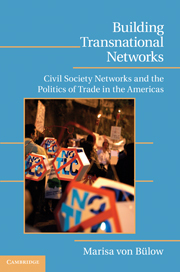Book contents
- Frontmatter
- Contents
- List of Figures
- List of Tables
- Acknowledgments
- Part One Civil Society Organizations and Their Pathways to Transnationality
- Part Two The Politicization of Trade
- Part Three The Dynamics of Networks
- Part Four Organizational Pathways to Transnationality
- Part Five The Search for Ideational Pathways
- Main Abbreviations Used
- Appendix A Lists of Interviews
- Appendix B Social Network Questionnaire (United States)
- Bibliography
- Index
Appendix A - Lists of Interviews
Published online by Cambridge University Press: 05 October 2010
- Frontmatter
- Contents
- List of Figures
- List of Tables
- Acknowledgments
- Part One Civil Society Organizations and Their Pathways to Transnationality
- Part Two The Politicization of Trade
- Part Three The Dynamics of Networks
- Part Four Organizational Pathways to Transnationality
- Part Five The Search for Ideational Pathways
- Main Abbreviations Used
- Appendix A Lists of Interviews
- Appendix B Social Network Questionnaire (United States)
- Bibliography
- Index
Summary
Three types of interviews were conducted for this study, most of them between May 2004 and August 2008, with actors from Brazil, Canada, Chile, Mexico, Peru, the United States, and Uruguay (see Table A1). Structured interviews using a social network questionnaire were done with informants from 123 civil society organizations (CSOs) from Brazil, Chile, Mexico, and the United States (listed in Tables A2 through A5). Semistructured and in-depth interviews were held with other civil society informants, government officials, parliamentarians, legislative staff, and international organization officials. Their names, affiliation, and the date and place of the interview are listed in Table A6, with the exception of interviewees that requested anonimity.
In many cases, more than one person from the same CSO was interviewed to answer the social network questionnaire. In other cases, individuals were interviewed more than once, and, sometimes, the same individuals were interviewed in more than one organization, as they switched jobs over the years. That is why the total number of questionnaires is different from the number of individuals interviewed in Table A1. The number of semistructured and in-depth interviews with CSOs is also different from the total number of interviews, which includes those undertaken with government officials, parliamentarians, legislative staff, and international organization officials (listed in Table A6).
- Type
- Chapter
- Information
- Building Transnational NetworksCivil Society and the Politics of Trade in the Americas, pp. 207 - 218Publisher: Cambridge University PressPrint publication year: 2010

